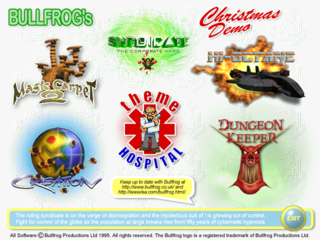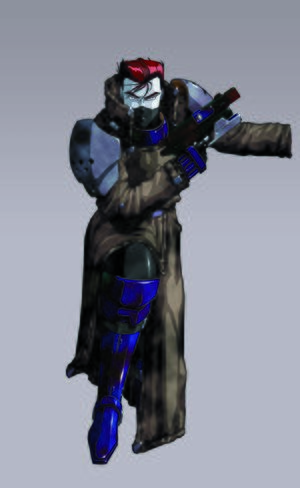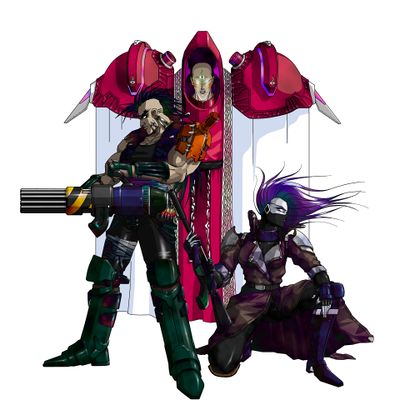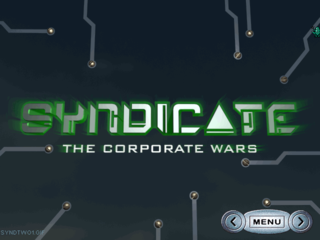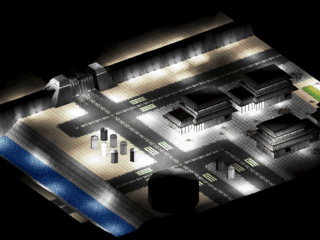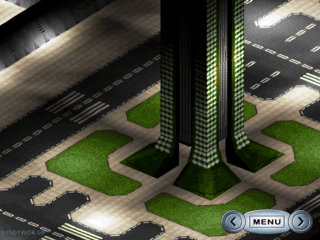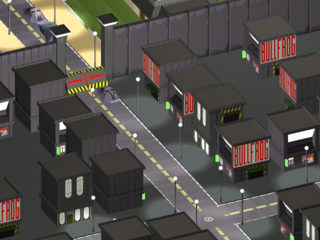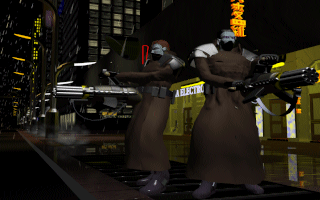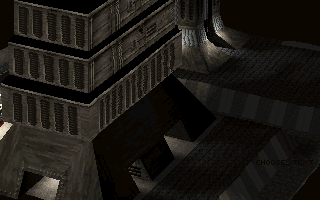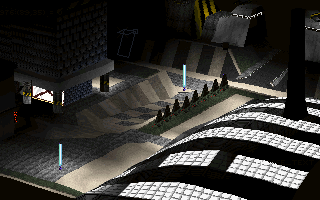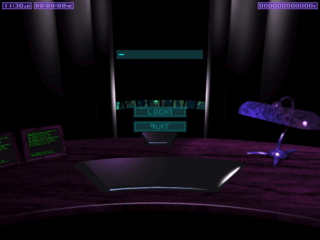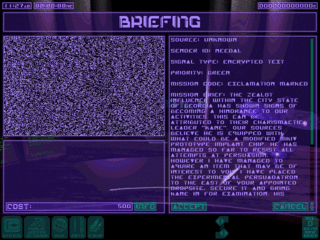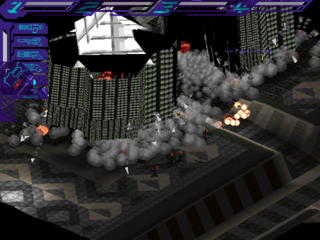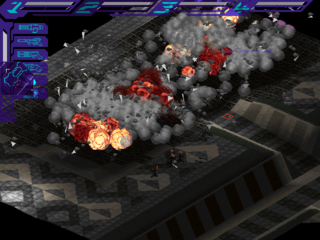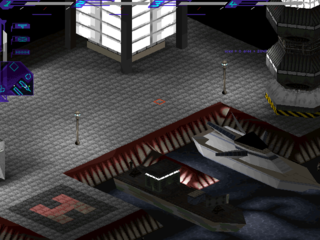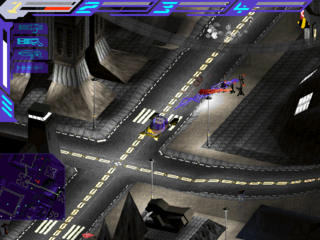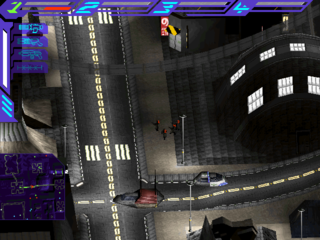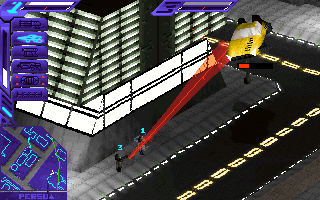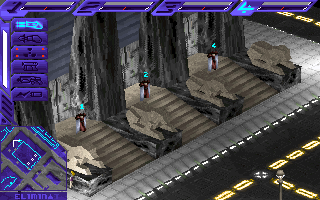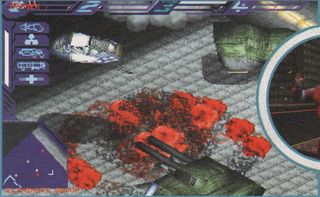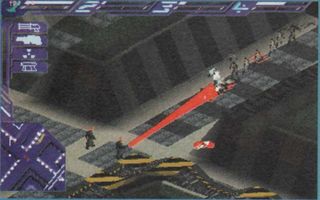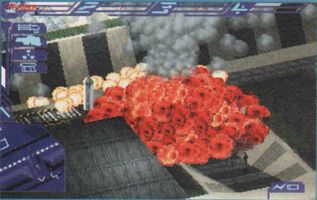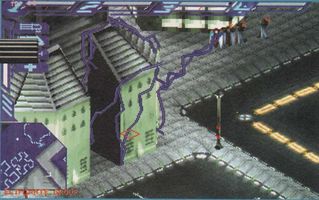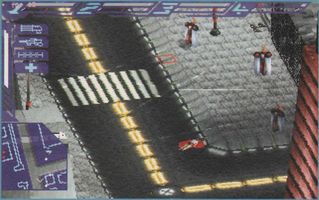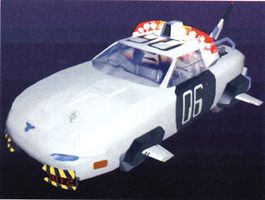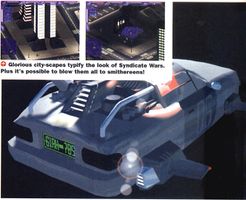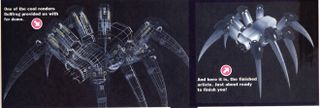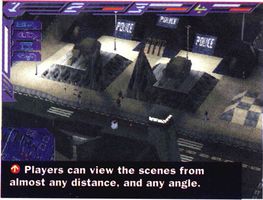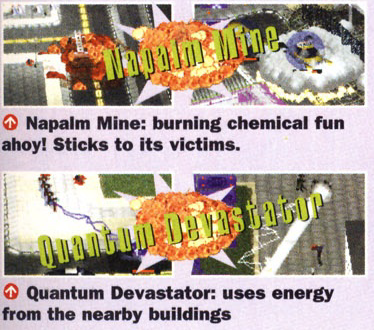Prerelease:Syndicate Wars (DOS)
This page details prerelease information and/or media for Syndicate Wars (DOS).
Contents
Development Timeline
1994
Lead Artist Mike Man creates some early concept art sketches for a new Syndicate game while working on Theme Park[1]. This culminates in the creation of a 3D animation based on the sketches that convinces Bullfrog to start work on a new Syndicate sequel. Mike Diskett requests to work on the game and becomes lead programmer[2].
The PlayStation was chosen as the lead platform for the game[3], with ports to PC and Sega Saturn planned. The game was intended to work on all platforms around a control system as found in the final PlayStation release, where the player directly controlled the lead agent, rather than the agent(s) moving towards clicks of a mouse as in the original Syndicate.
October
The game was announced to the press in September 1994 at the ECTS show, and an article in Joystick magazine issue 53 has some of the earliest resulting coverage on the game, at this point simply called Syndicate 2. The simplistic pre-rendered picture of a city seen in the press kit is also printed here for the first time, making it the oldest known piece of art related to the game.
1995
April
Screenshots are taken of a pre-alpha build and are included with the Forthcoming Products from Bullfrog Productions demo provided to some magazines. At this point in time the graphics are very low polygon, but the game has (for its time) a very sophisticated lighting system. At this point the game is called "Syndicate: The Corporate Wars"
July
Issue 62 of Joystick magazine includes what is likely the earliest known footage of the pre-alpha game on its cover disc.
The Bullfrog Progress Report video from this month shows a similar version of the pre-alpha build. In this version vehicles are fully working and have headlights that use real light sources. While the video implies this is the PlayStation version of the game, the DOS version's mouse cursor is seen on-screen in some parts suggesting it is running on a PC.
August
Second programmer Ben Deane starts work on the game, specifically working on improving the game's editor[4].
October
A pre-alpha rolling demo was created for inclusion on the Bullfrog's Christmas Demo CD sold by Bullfrog over Christmas 1995 (although it would also later appear on magazine cover discs in mid 1996). Control still worked as per the original concept with the player character controlling a single agent directly using the keyboard. Vehicles are not working in this build, but this may be deliberate. According to the menu that launches the demo, at this point, The Church of the New Epoch was named the "Cult of !".
December
Ben Deane begins work on the menu screen system[4].
1996
January
The pre-rendered FMVs for the game are created, most notably the introduction. At this point the Zealots are still named the "Cult of !" or "Church of !"[5]. and this is why the FMV for winning a Zealot mission shows a giant "!" in the sky in the final game. The menu system for the game is complete in it at least its first incarnation, as seen in the press kit. Somewhere around the start of 1996 the game was finally renamed to Syndicate Wars.
March
Almost all work on levels this month was exclusively for unguided campaign missions, based on their file timestamps. After this point in development there seems to be little further work carried out on any unguided campaign mission aside from the suspected demo level, mission 103, in July. Filepath data in the executable also shows the (cut) background for the unguided menus uses a different older data path to that of the other two factions, so it seems a decision to abandon the faction must have been made around here and the result was the unguided did not survive the game's refactoring to the alpha build. Possibly mission 103 was to be a demo for an unguided data disk that never happened.
April
The game reached Alpha status[6]
, with all basic features now implemented. By this stage, the game featured more complicated polygon environments and the earlier more complex lighting had been replaced with a much simpler but more performative iteration. The game was by now intended to run in 640 x 480 resolution and all screenshots from this period show as much, with the view zoomed far out. It seems at this point the game still used the direct control scheme. Screenshots use what the final game dubbed the "Oceanic Translucency" control panel style. Somewhere around here the Zealots are renamed the Church of the New Epoch.
May
The team reportedly decide to scrap all pre-alpha levels now the game is in alpha status due to advancements made in the level editor and new NPC commands and the worry these simpler older levels will not do the game justice[7]. Analysis of the level files included with the game show that in fact most levels were derived from early pre-alpha experiments and continued to the final release. However, they were redone to take advantage of these new features. Specifically the ability to make characters invisible to spawn them in later or essentially work as "stage hands" for scripted sequences drastically changed what was possible in the game. Notably the cut Unguided campaign levels were created before this innovation and show the difference between the pre-alpha and final game capabilities in how relatively crude they are.
June
A report in Joystick magazine shows a mixture of screenshots already seen in press kits, but also new ones of a later version of the alpha build that seem to show its view is now heavily zoomed in as per the final game.
July
Screenshots from what appear to be be a Beta build appear, and a similar beta demo is created that will be available on magazine cover discs later in the year. At this point the game changed to the "Metal Lightning" control panel style going forward (although the original style is available for use in the final game as well). By now control has been switched to use the mouse as in the original Syndicate (although the old direct control scheme is also available in the final game still). The Beta screenshots still show the same single weapon control panel style as seen in the alpha builds. However, the released demo from late in this period has the final game's interface design, with four separate weapon menus. The beta screenshots are now all in low resolution mode, and both the demo and the final game itself now default to this mode (although high resolution is still available in both).
November
Syndicate Wars was released. The post-release demo was put up on Bullfrog's website.
1997
January
The PlayStation version of the game is radically revamped. Map files from the Korean DOS version of the game show they were being simplified at this time, presumably due to some kind of performance/RAM issues. The outcome of this work was the scrapping of the first build of the game and an overall design simplification for the console that led to six months more development.
February
Following Creation producer Guy Simmon's resignation, Syndicate Wars Lead Programmer Mike Diskett also quits Bullfrog to form developer Mucky Foot together.
March
The Sega Saturn version of the game is officially cancelled, with Bullfrog citing fears over low sales due to the declining Saturn market share[8]. According to an extremely in-depth article in the UK Sega Saturn Magazine[9] the Saturn version was complete save for FMV playback[10]. It's likely this version was scrapped once the PS1 version was radically redesigned, with the cost of further development to bring it up to par deemed unviable.
June
The Japanese Windows 95 version of the game is finished by Electronic Arts Victor. The Windows version of the game was never released outside of Japan.
July
The PlayStation version of the game is finally released. By this stage it's very different in almost every way. It runs in low resolution only, has a different game engine with more sophisticated lighting but greatly cutdown AI and path finding algorithms, and many gameplay elements are removed such as trains and research. The menu interface is also totally different and simplified compared to the PC version.
Concept Art
Syndicate Wars artist Mike Man posted the above images on his Artstation account in 2018. These are promotional/concept art depictions of a male syndicate agent, and a second image of a female syndicate agent, a male Unguided, and a Zealot. They were previously printed in various videogame magazines. The second image was drawn to represent the three playable factions in the game, before the Unguided campaign was cut. The Unguided were also referred to as "Bikers" at this time, as per the menu screenshots below.
His commentary is also interesting, revealing that originally the game was intended only to run in the higher resolution mode, and all his in-game character art was drawn with this in mind. He also states that as per many of the early screenshots in the press pack below, the game was intended to always be seen zoomed out, with the change to make the zoom level dependent on the chosen weapon a later addition forced by management that many of the team felt a poor choice (and indeed is a common criticism of the game).
Bullfrog Progress Report July 1995
This video, released on magazine cover discs, shows early footage of a pre-alpha build. It seems to use the exact same map as the released demo but it clearly shows vehicles fully working with complex lighting from their headlights, when these don't seem to work in the later released demo from this period. However, explosions work differently here, with a simpler effect used. Buildings simply shatter into a few polygons with sprite-based debris flying out, unlike the collapsing effect used in the pre-alpha demo that was further refined for the final game. At the very end of the clip a car can also be seen driving off-road.
The title card for the game says at this point the lead platform is the PlayStation, and predicts an alpha build will be ready for January 1996, with a beta following in February and the final game released in March 1996.
Trailer
An official trailer for the game can be found on Youtube. Created in July 1996, it was originally included as a bonus on the CD of the American "CD-Rom Classics" re-release of Magic Carpet, and was later posted on Bullfrog's official site in December 1996.
It briefly shows the game's alpha build as per the Press Pack images below, with the flat shaded interface graphics, zoomed out view and the weapons bar shown only on the far left of the screen.
Forthcoming Products From Bullfrog Productions
In 1995 Bullfrog released a simplistic manual viewer program previewing their in-development games called Forthcoming Products From Bullfrog Productions. This was released on the cover disc of PC Player magazine in various countries, most notably with the June 1995 issue of the German PC Player magazine. Found on the internet it consists of a preview of official Bullfrog screenshots of games in development in 1995/96, including Dungeon Keeper, Theme Hospital, Syndicate Wars, Creation, and others. The early screenshots within were printed in all the videogame magazines at the time (an example: PC Zone issue 42), and show the game in very early pre-alpha stage of development.
"Catalog" Program Images
This is a DOS executable called "View" that is some kind of generic interactive manual viewer created by Bullfrog. This program contains a short brochure of further images and information on Bullfrog's games from the era, including four very early screenshots of Syndicate Wars. Unfortunately the raw pictures inside the .dat files have the menu buttons actually written onto the picture itself, they are not an overlay that can be removed.
These are four images clearly from very early in development. As in the Pre-alpha rolling demo the game is called "Syndicate The Corporate Wars". What follows are three extremely early screenshots of overviews of various parts of cities. These don't seem to match maps from the final game, but some of the building designs are used in the final game. It's also noticeable that at this stage the streets and other details are entirely flat, with detail only textured on with no depth. This is the same as in the rolling demo, so is likely to be from the same build.
Note: The middle two images below were also published unaltered as part of issue 14 of the CD-ROM magazine Interactive Entertainment from June 1995 so have been replaced here from that source. Unmarked versions of the other two images have not been found.
Press Kit Images
Bullfrog released an official press kit consisting of images and a press release for the game that were printed in magazines at the time, and the kit itself included in its entirety on various magazines.
Press Release
There is an image file containing a press release on the game.
SYNDICATE WARS The original Syndicate scenario drew to a close with the establishment of global domination by The Corporation. Now a hundred years later, complacency has set in and things are going wrong. The chip which controlled the minds of the world’s population has started to malfunction and once again the citizens of the world are perceiving reality as it really is – grim. A new quasi-religious cult springs up and gains huge numbers of converts to its cause, while in the cities, marauding gangs of disenfranchised citizens called The Unguided capitalise on The Corporation’s disorganisation and gains control of whole city precincts. This is game-noir. The world of Syndicate Wars teeters on the brink of apocalypse. This time the player can Choose to be a Corporation executive determined to place The Corporation back in control, a Church Elder possessed by a post-syndicate vision or the leader of The Unguided. Syndicate has become an undisputed classic with its blend of strategy and action and has almost universal recognition within the gaming fraternity. Technological advances, coupled with consumer demand, led Bullfrog Productions to decide to create a sequel to this classic program. The game is set in a fully 360 degree rotatable landscape with dynamic light sourcing. Everything in each of the thirty cities can be completely destroyed. This means that you can enter a thriving city and leave it as a smoldering crater (assuming you have the appropriate weaponry). Other technological advances have enabled Bullfrog to use Video streaming to play CD resident movie footage on the side of buildings. A more sophisticated mission structure leads agents to multiple locations in the quest to fulfill their objectives. In addition, failure to complete critical parts of the mission result in the mission changing, so should a prisoner escape – for example - your agents may receive new orders to track him down. The weaponry in Syndicate wars is as spectacular as the cityscapes, with twenty-four weapons in all. These include old favourites such as the Uzi, Minigun and flamer and new weapons – shield-puncturing tasers, napalm mines, razor wire and many more. Syndicate Wars will be a worthy successor to its classic parent. The new setting, technological advancements and the fact that now the player can directly control the lead agent all combine to further enhance playability. The introduction of two new groups means that players will have to use different tactics in order to win the game, depending on which side they opt to take. Syndicate Wars will be published for the PC CD and the PlayStation in September 1996 by Bullfrog Productions. Both versions priced a 44.99 and distributed worldwide by Electronic Arts. For further information please contact Cathy Campos on 01483 579399.
The press release still mentions that the Unguided will be a playable faction and that the player would "control their leader". It also mentions the known cut weapons the napalm mine and taser.
Concept Art
There is a single pre-rendered 3D picture that was used as concept art for the game. This was previously printed in Joystick magazine in October 1994 making it the earliest picture in the pack.
CGI Frames
The pack contains a few exported frames from the game's CGI intro. These are in both high res and low res formats. Some of the low res frames are not actually in the intro. The image of the agents firing seems to have been adapted from the similar scene in the intro but moves them closer to the edge of the road as it frames the characters better, and was used for promotional purposes. The render of the empty street isn't seen in the final intro at all.
Early Map Overviews
These are overviews of game maps taken from high up in the game engine. These consist of earlier versions of maps that all made it to the final game.
| Prerelease | Final |
|---|---|
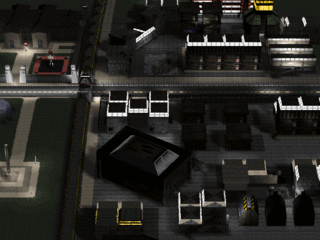 |
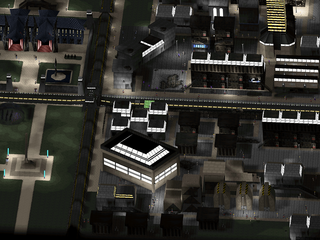 |
Map 44 - Cape Town. This is pretty similar to the final, but the church building uses a totally different model here. There's also a statue outside the church where this is a twisted Zealot pillar in the final game. There are many texture changes across the buildings.
| Prerelease | Final |
|---|---|
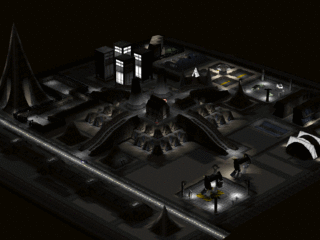 |
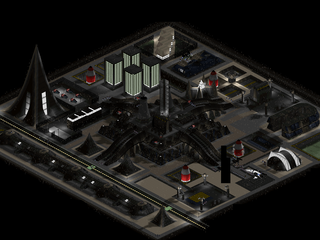 |
An early version of map 46 - Columbo. This is missing the central Space Elevator, and seems to feature what appear to be a pair of cut mecha vehicles closest to the camera. The missile defence systems are not yet present in this iteration, and indeed some of the early cut versions of the Columbo levels seem to expect them to not be there, placing NPCs in these areas - they were likely created for this version of the map. The move to greater simple global illumination lighting is also evident, with the numerous alcove lights in the central area removed in the final version.
Menu Interface Screenshots
The menu screens are broadly the same as the final game's, but have some common features that were cut for the final release. Specifically all screenshots show a "Public Access Network" icon at the bottom of the screen. While the graphic for this is included in the final game's files, they are cut and it's unknown what this would do. There's also an icon that looks like a letter S to the middle right of the game icons that is also unknown but present in the final game files.
Multinet Access. An early version of the multiplayer screen. This has a very different layout to the final game. There are three team choices unlike the final game, with the cut Unguided faction selectable as "Bikers" (an early name for their faction). Tech and money levels are also placed inside the same UI box rather than with their own dedicated sliders like the final game. There are also a pair of options marked "Solo Operations" and "Dual Operations". It's not apparent what they would do other than something to do with single player vs cooperative modes?
Map screen. This seems largely identical to the final game. However, there is some kind of pink thing to the left of the UK that may have been an early mouse pointer for this mode. This graphic is present but unused in the final game files. The country summary is also quite basic at this point. Interestingly this also features a heading called "Status" which is empty in the screenshot, but seems to be leftover from the original Syndicate where it was possible for countries to rebel, causing a mission to have to be repeated. There also seems to be a mission point in Antarctica, whereas there isn't one in the final game.
Early Briefing screen. This is mostly identical to that of the final game. However, the briefing uses a different, larger font to the final game. There's also some kind of static effect instead of a map for the briefing. The "Netscan" button to get more information is labelled "Info" here. Visible also is what seems to be a mock up of a mission that is not in the final game. This dates back to when the Zealots were named the "Cult of !" - hence why the mission here is called "exclamation marked". The leader of the Zealots is said to be called "Kane" here, sounding somewhat like a homage to the villain of Robocop 2.
High Resolution Alpha Build Screenshots
These screenshots seem to come from the same early build. Notably they are a) all in the high resolution screen mode and b) are fully zoomed out, much like the commentary from Mike Man suggests the game was intended to be run as early on. Agents in this build also have red numbers above their head rather than turquoise ones like the final game. It also seems to have a debug mode enabled in some screens - there is a red outline highlighting individual ground tiles, and a piece of text noting something as "used" and "free".
Another thing that is interesting in all of these screenshots is that the weapon panel is always visible on the far left of the screen, and individual agents do not seem to have their own weapon menu. Possibly this was an attempt to ape how the original Syndicate worked, where the left hand side of the screen was a dedicated control panel. It seems this was later abandoned for the final game's individual weapons panels for each agent.
The laser seems to look like it did in the pre-alpha demo here, as small bursts of red light rather than a long constant shaft of light as in the final game. There's also an early rough version of the KO Gas icon, or possibly it's the low res asset stretched to high res proportions. Finally, the early asymmetric blue weapon lock on cursor from the pre-alpha demo is visible here.
Note the mission objective message written in red over the middle of the map. The currently selected weapon also seems to be some kind of assault rifle-like weapon that is not in the final game, and a crude early graphic for some other kind of object or weapon is visible below it that is not in the final game.
This picture is interesting as it shows the low resolution HUD graphics. However, they are displayed as if the game is using the high res mode assets (because the screen is in that mode), so they are out of place and the health bar of each agent is clearly misaligned with the interface. This bug occasionally happens in the very early demo of the game when loading a level from the command line. The map is also in the wrong position, overlaid over part of the weapon meter and the actual weapon icons.
Later Low Resolution Beta Build
These seem to be from a later build of the game, using nearly the same version of the interface as the earlier of the two playable demos, with the newer embossed looking UI icons and the red markers for limited munitions. However, they still only show one weapon menu on-screen, so likely come from before that demo build and the design change to have four independent weapon menus. Things seem to be the same as that demo build otherwise, with the laser now acting as the final game's does, firing a single continuous beam.
Magazine Coverage
Most early magazine coverage used a subset of the press pack images above, so there is little to see in most magazine previews that was not already shown in the pack. However, the following magazines featured interesting articles and screenshots on the game.
Maximum Magazine
Issue 4 of Maximum magazine from February 1996 has some of the most detailed information yet found on the cancelled Unguided campaign:
"The final selectable power, the Unguided, only becomes available after the player has completed the game as either the Church or the Syndicate. As these neo-punk biker gangs have no high tech research options, their current scenarios are based on weight of numbers, conquest and capture. The Unguided's objectives are not clear at the moment, though they receive their orders from Ko-paull Vissick, an ex-member of the ORG who seems to be the only person on Earth who really understands the monumental problems that everyone faces."
Joystick Magazine
Issue 62 of the French Joystick magazine from July 1995 has some extremely interesting early footage of the game included as an AVI file on its coverdisc. This video shows the use of editor features as agents and zealots are added to a level, as well as various light sources. Buildings are destroyed, which uses the same simple shattering effect as the progress report video. There is also lots of footage of an early vehicle, which at this point does not follow the roads and can go anywhere. The car has light sourced headlights like the vehicles seen in the progress report video.
What's also very interesting is the start of this video. It shows a CGI animated sequence of what looks like the early concept art design of a police car flying towards a city scape. It's entirely possible this may in fact be the 3D animation Mike Man created in 1994 to spark interest in a Syndicate sequel.
Issue 72 of Joystick magazine from June 1996 has some very interesting screenshots of the game clearly in transition from the alpha build to the later beta build. All screenshots are now in the low resolution mode (as is the case with all official screenshots of the game going forward). The control panel is still the original "Oceanic Translucency" style, but there is now the seemingly temporary DANGER warning visible from the beta, as well as an FPS counter in all screenshots. Agents still have their number in red above their head whereas this became turquoise in the beta and final game.
Issue 72 of the magazine also had a series of video previews and interviews around various games Bullfrog had in development at the time. A short interview with Mike Diskett oddly shows some already very outdated pre-alpha footage, but then moves on to very interesting clips from the then-current alpha build. This demonstrates how at the time the mouse cursor had a red square highlighting exactly where on the ground clicks would send characters, and also shows a cut kind of floating traffic light object that is not in the final game. This footage seems to be slightly older than the build shown in the screenshots in the same magazine.
Computer and Video Games Magazine
Issue 174 of Computer and Video Games magazine from May 1996 has a preview on the game that includes a lot of very interesting screenshots including lots of concept art. Oddly the article claims that weapons in the game would have to be recharged at "Energy Consoles".
Concept art of a police car as printed in many other magazines. It's nothing like the final game's model, but is the same one that can be seen in the very early Joystick pre-alpha CGI. Peculiarly this was also used to promote Hi-Octane, and indeed features on the boxart of the console version of that game
The best quality known print of an image clearly from the same batch as the press kit, this time of the equipment screen. This shows further early names for weapons, with the Electron Mace named "Electrical Laser", the Launcher called the "G.R.A.P Launcher" and the Ion Mine called "Electro Mine". The cut Napalm Mine weapon is visible with an icon like the final explosives one. The Flamer here also uses a different icon that is similar to that of the one from the original Syndicate
Issue 178 of Computer and Video Games magazine from September 1996 has a box out that purports to show the Napalm Mine in action (although it looks like the regular explosive, which may be why it was cut). It also confirms the early name of the Graviton Gun as the "Quantum Devastator".
GamesMaster Magazine
Bullfrog's Mike Diskett wrote a "Syndicate Wars Diary" column for GamesMaster magazine between issues 40 and 44 (March to July 1996). These reveal the following:
- The early high resolution build screenshots in the press pack are from the Alpha build of the game
- An aside mentions NPC objectives such as "Get Key, Open Armoured Dome, Enter Tank". This seems to be an insight as to how the useless domes found throughout the game were actually intended to work.
- There is a mention of getting the game working in Windows 95. It's not clear if this is referring to DOS compatibility running through Windows or if there was actually a Windows build of the game created by Bullfrog, as Syndicate Wars was only released as a DOS game in most of the world. The later Windows version of the game was released exclusively in Japan.
References
- ↑ Melissa Tyler (1996), Bullfrog's Official Guide to Syndicate Wars. Prima Publishing. p. 224. ISBN 0-7615-0089-8
- ↑ Melissa Tyler (1996), Bullfrog's Official Guide to Syndicate Wars. Prima Publishing. p. 218. ISBN 0-7615-0089-8
- ↑ John Davison. Blueprint. Syndicate Wars. PC Zone 34 Dennis Publishing. January 1996 p. 47. ISSN 1354-070X
- ↑ 4.0 4.1 Melissa Tyler (1996), Bullfrog's Official Guide to Syndicate Wars. Prima Publishing. p. 220. ISBN 0-7615-0089-8
- ↑ Old Syndicate Wars Storyline - Syndinet, June 1997
- ↑ Mike Diskett, Syndicate Wars Diary Part 3. GamesMaster. No. 42. Bath: Future plc. May 1996. p. 31. ISSN 0967-9850.
- ↑ Mike Diskett, Syndicate Wars Diary Part 4. GamesMaster. No. 43. Bath: Future plc. June 1996. p. 20. ISSN 0967-9850.
- ↑ SEGA Saturn Version of Syndicate Wars Cancelled - Coming Soon Magazine, March 1997
- ↑ Matt Yeo. Coming Soon. Syndicate Wars. Sega Saturn Magazine 18 EMAP. April 1997 p. 18. ISSN 1360-9420
- ↑ 1997 Retrospective. Sega Saturn Magazine 28 EMAP. February 1998 p. 13. ISSN 1360-9420
